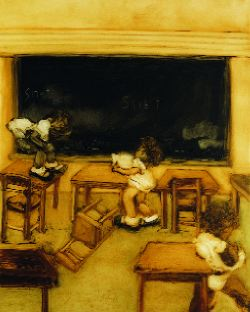Kim Dingle
Sperone Westwood, New York, USA
Sperone Westwood, New York, USA

The saccharine Mary Bells in Kim Dingle's show 'Never in School' resemble nasty little meringues. François Boucher painted women to look like elegant cake decorations, while Renoir's women resemble overgrown milk puddings who could satisfy the gamut of sexual and gastronomical needs. While fleshy, Renoir's female figures are not like those featured in Rubens' paintings, who, even when lounging on Mount Olympus, the latter look as if they could laugh, fart and screw like a pack of Hell's Angels. As rebuttal or retribution, feminist artists such as Janine Antoini, Hannah Wilke or Karen Finley have attacked this food metaphor with a punk rock giggle.
Dingle, whose characters look like evil pastries, also takes on insidious assumptions about acceptable female behaviour. Her work points to a downward trajectory in the maturation of girls: the characters that populate her paintings seem to be having a wild time being very, very bad. Like a pack of diminutive Kat Bjellands and pre-movie star Courtney Loves, Dingle's girls attack the sensual atrophy of adulthood where candy becomes more of a threat than a treat and antiquated notions of 'good girl/bad girl' still secretly prevail.
As in Ida Applebroog's work, the surfaces of Dingle's paintings appear slick and raw, and are created from an almost monochromatic palette of sickly-sweet colours: hot fudge, butterscotch, white chocolate and maple. Painted in the manner of a rejected child pushing left-over syrup around a paper plate, the paintings could be read as a little girl's hieroglyphic documentation of her exploits.
Earlier there was only one character in Dingle's oeuvre, Priss, who might have been dressed like Shirley Temple but was rougher and naughtier than Dennis the Menace because she could manipulate any adult with a coy twist of her little shoes. Later, Priss split like a gremlin into a pair named Fatty and Fudge. With a Hobbesian worldview, Dingle has Fudge, a little black girl, and Fatty, a little white girl, act either as cohorts or adversaries battling each other like members of the WWF or playground buddies in Valhalla. In Never in School (all works 2000) Fatty and Fudge have many little playmates but they are the ringleaders, in school classrooms and playgrounds without adults or boys.
Never in School (Two Girls, One Barfing) depicts Fudge forcing Fatty's head downward as Fatty vomits up a slick butterscotch-coloured mess. In Never in School (Guess Who) Fudge yanks Fatty backwards in a vicious wrestling move. Standing behind, with her arm locked over his eyes, Fudge pushes one of Fatty's pudgy arms behind her back. She bends his marshmallow body so far backwards that her skirt floats over her navel and a pair of white panties floats over Fatty's chocolate smeared legs and liquorice sandles.
Panties are a key part of the girls' prim dolly-pie costume, but there is nothing sexual or sexualized about them. Dingle, who is Californian, works in a country where Rousseau's ideas of the child as innocent blank slate are upheld with furious vigilante devotion. This myth explains why Sally Mann's art is lumped in the same category as the mawkish photos of somnambulistic pre-pubescent girls taken with hazy Penthouse lighting by camera-packing Humbert Humbert David Hamilton. For Dingle's girls, like Mann's, strength does not lie in the ability to get grown-ups or men to protect them, but in their ability to be strong for themselves.
In Dingle's world there is really no victim or motive, only restive schadenfreude. The girls bully each other because it is fun without a real sense of consequence. When children, such as eleven-year-old murderer Mary Bell, kill other children they do not comprehend the permanence of death. Never in School exists in the same child's world without real physical damage and there are no images of the aftermath of the malicious play. Fatty, Fudge and the girls display a sociopathic absence of empathy, particularly when competing motives such as greed or fun are more pressing. For Dingle, as for Margaret Atwood, 'children are only children to adults; to each other they are life-size.'














